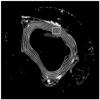The presence of two local myocardial sheet populations confirmed by diffusion tensor MRI and histological validation
- PMID: 21932362
- PMCID: PMC3195899
- DOI: 10.1002/jmri.22725
The presence of two local myocardial sheet populations confirmed by diffusion tensor MRI and histological validation
Abstract
Purpose: To establish the correspondence between the two histologically observable and diffusion tensor MRI (DTMRI) measurements of myolaminae orientation for the first time and show that single myolaminar orientations observed in local histology may result from histological artifact.
Materials and methods: DTMRI was performed on six sheep left ventricles (LV), then corresponding direct histological transmural measurements were made within the anterobasal and lateral-equatorial LV. Secondary and tertiary eigenvectors of the diffusion tensor were compared with each of the two locally observable sheet orientations from histology. Diffusion tensor invariants were calculated to compare differences in microstructural diffusive properties between histological locations with one observable sheet population and two observable sheet populations.
Results: Mean difference ± 1SD between DTMRI and histology measured sheet angles was 8° ± 27°. Diffusion tensor invariants showed no significant differences between histological locations with one observable sheet population and locations with two observable sheet populations.
Conclusion: DTMRI measurements of myolaminae orientations derived from the secondary and tertiary eigenvectors correspond to each of the two local myolaminae orientations observed in histology. Two local sheet populations may exist throughout LV myocardium, and one local sheet population observed in histology may be a result of preparation artifact.
Copyright © 2011 Wiley Periodicals, Inc.
Figures


















Similar articles
-
Diffusion tensor MRI of myocardial fibers and sheets: correspondence with visible cut-face texture.J Magn Reson Imaging. 2003 Jan;17(1):31-42. doi: 10.1002/jmri.10223. J Magn Reson Imaging. 2003. PMID: 12500272
-
Measuring and mapping cardiac fiber and laminar architecture using diffusion tensor MR imaging.Ann N Y Acad Sci. 2005 Jun;1047:296-307. doi: 10.1196/annals.1341.026. Ann N Y Acad Sci. 2005. PMID: 16093505 Review.
-
Reconstruction and visualization of fiber and laminar structure in the normal human heart from ex vivo diffusion tensor magnetic resonance imaging (DTMRI) data.Invest Radiol. 2007 Nov;42(11):777-89. doi: 10.1097/RLI.0b013e3181238330. Invest Radiol. 2007. PMID: 18030201
-
Remodeling of cardiac fiber structure after infarction in rats quantified with diffusion tensor MRI.Am J Physiol Heart Circ Physiol. 2003 Sep;285(3):H946-54. doi: 10.1152/ajpheart.00889.2002. Epub 2003 May 22. Am J Physiol Heart Circ Physiol. 2003. PMID: 12763752
-
Myocardial mesostructure and mesofunction.Am J Physiol Heart Circ Physiol. 2022 Aug 1;323(2):H257-H275. doi: 10.1152/ajpheart.00059.2022. Epub 2022 Jun 3. Am J Physiol Heart Circ Physiol. 2022. PMID: 35657613 Free PMC article. Review.
Cited by
-
Diffusion tensor imaging and histology of developing hearts.NMR Biomed. 2016 Oct;29(10):1338-49. doi: 10.1002/nbm.3576. Epub 2016 Aug 3. NMR Biomed. 2016. PMID: 27485033 Free PMC article.
-
Construction and Validation of Subject-Specific Biventricular Finite-Element Models of Healthy and Failing Swine Hearts From High-Resolution DT-MRI.Front Physiol. 2018 May 29;9:539. doi: 10.3389/fphys.2018.00539. eCollection 2018. Front Physiol. 2018. PMID: 29896107 Free PMC article.
-
Simulation Methods and Validation Criteria for Modeling Cardiac Ventricular Electrophysiology.PLoS One. 2014 Dec 10;9(12):e114494. doi: 10.1371/journal.pone.0114494. eCollection 2014. PLoS One. 2014. PMID: 25493967 Free PMC article.
-
Next-Generation Cardiac Magnetic Resonance Imaging Techniques for Characterization of Myocardial Disease.Curr Treat Options Cardiovasc Med. 2024 Aug;26(8):243-254. doi: 10.1007/s11936-024-01044-4. Epub 2024 Aug 9. Curr Treat Options Cardiovasc Med. 2024. PMID: 40291164 Free PMC article.
-
Resolving Fine Cardiac Structures in Rats with High-Resolution Diffusion Tensor Imaging.Sci Rep. 2016 Jul 28;6:30573. doi: 10.1038/srep30573. Sci Rep. 2016. PMID: 27466029 Free PMC article.
References
-
- Chen J, Liu W, Zhang H, et al. Regional ventricular wall thickening reflects changes in cardiac fiber and sheet structure during contraction: quantification with diffusion tensor MRI. Am J Physiol Heart Circ Physiol. 2005;289(5):H1898–1907. - PubMed
-
- Costa KD, Takayama Y, McCulloch AD, Covell JW. Laminar fiber architecture and three-dimensional systolic mechanics in canine ventricular myocardium. Am J Physiol. 1999;276(2 Pt 2):H595–607. - PubMed
-
- LeGrice IJ, Smaill BH, Chai LZ, Edgar SG, Gavin JB, Hunter PJ. Laminar structure of the heart: ventricular myocyte arrangement and connective tissue architecture in the dog. Am J Physiol. 1995;269(2 Pt 2):H571–582. - PubMed
-
- LeGrice IJ, Takayama Y, Covell JW. Transverse shear along myocardial cleavage planes provides a mechanism for normal systolic wall thickening. Circ Res. 1995;77(1):182–193. - PubMed
Publication types
MeSH terms
Grants and funding
LinkOut - more resources
Full Text Sources

